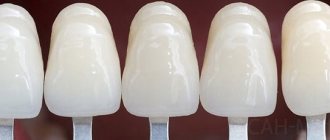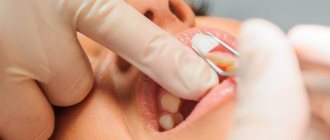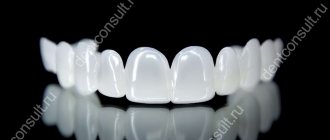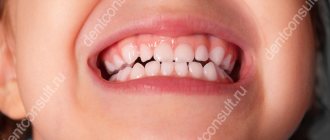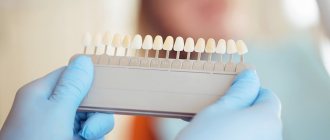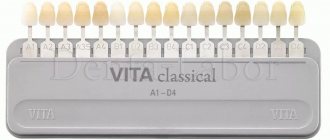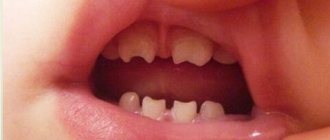Dental veneers are microprostheses that are installed to restore the correct shape of teeth and improve their color. They are recommended when classical methods of whitening and removing defects have not brought positive results. The structures are practically no different from natural teeth. Unlike classic dentures, plates made of composite materials, ceramics and porcelain are strengthened only on the front surface of the teeth. Fixed prosthetics always require turning. Correct defects with veneers without grinding teeth. Is this really possible?
Veneers and teeth grinding are the main problems
With the help of veneers, aesthetic and functional problems are solved. They change the shape of teeth, eliminate unevenness in the enamel, hide yellowness and pigmentation, the presence of old fillings, external defects, and reduce large gaps between teeth. Installing veneers not only restores your smile to its lost beauty, but also rejuvenates your face.
Although the thickness of veneers ranges from 0.2 mm-0.5 mm, they are considered very reliable and have little wear. Thin plates must have a high density of contact with the tooth. This requires preliminary grinding. This procedure often becomes an insurmountable obstacle for patients who are candidates for veneers. How does the preparation process take place and does it really seriously harm the teeth?
Is it possible to restore a ground tooth after this?
Hard dental tissues, in particular enamel, do not have the ability to grow a new layer to replace the polished one. Otherwise, dentists would not put fillings, but would wait “until it heals on its own.” A ground tooth can only be restored with a new veneer or filling (direct restoration). If you refuse restoration and leave everything as is, then the remaining enamel will not look aesthetically pleasing - it will not have shine, and its protective functions (from caries, overheating and injuries) will be greatly reduced.
Author: Mikhailova (. M. (Thank you for your help in writing the article and the information provided)
Is it possible to install veneers without turning?
In most situations, standard porcelain veneers cannot be installed without grinding. However, the use of modern technologies makes it possible to create veneers of smaller thickness, up to a maximum of 1 mm. Strong grinding exposes dentin, as a result of which porcelain adheres much less well. Minimal grinding allows you to preserve healthy enamel, on which veneers adhere much better.
The stitching procedure is not required in the following situations:
- with severe tooth wear;
- obvious unevenness of the cutting edge;
- incorrect position of teeth;
- with an initial lack of volume;
- if installation without stitching looks more aesthetically pleasing;
- crooked teeth.
In such cases, lumineers and ultraneers are recommended, which do not require preliminary tooth preparation. Their installation requires only minimal processing, which is carried out without anesthesia.
Nanoneers - what are they?
Nanoneers or nanoveneers are ordinary veneers that are created from a material with the addition of nanoparticles, due to which standard ceramics acquires different properties. Nanoneers are also created in Russian laboratories, but from materials and technology developed in Switzerland. As a rule, to fix nanoveneers, preparation of tooth enamel is not required, however, after installing them on the crown, the product is thoroughly polished and adjusted to the size of the tooth.
It should be noted that well-known manufacturers of ceramics for the manufacture of veneers are constantly improving technologies and adding particles to the ceramic mass that improve the mechanical and aesthetic properties of this type of microprosthesis. In particular, both e.max technology and feldspathic technology have their own similar secrets.
Disadvantages of installing plates without turning
Veneers without grinding have a number of disadvantages. These include: increased tooth thickness, which seriously affects aesthetics, the risk of serious problems during wear, and the impossibility of eliminating all defects.
In order for the veneers to adhere better, the surface of the enamel must first be etched with a special acid, as a result of which its appearance will be seriously and irreversibly changed. In the future, plates will definitely have to be installed on such teeth. The small thickness of lumineers cannot completely hide all shape defects.
Preliminary grinding ensures the creation of a smooth and high-quality transition into dental tissue. Installation without grinding provokes the formation of caries, plaque accumulation and gum inflammation.
How is turning for veneers carried out?
Turning is carried out in several stages:
- using a diamond bur, grooves are created in a transverse direction;
- the tooth surface is polished;
- the middle surfaces directed towards the adjacent teeth are ground down;
- the cutting edge is ground (from 0.5mm to 2mm);
- the palatal surface is worn away.
Finally, final processing is performed, during which sharp corners are rounded and protruding edges are eliminated. For comfortable installation of the plate, the protrusions are removed to the level of the arch, and the entire tooth is ground. This is necessary to ensure that the veneers and teeth are not damaged after installation.
The dental procedure is considered completely painless. The veneer is installed on the tooth without anesthesia or using modern analgesics. The plate is carefully glued to the surface, and the remaining glue is removed. As a result, the appearance of the teeth becomes ideal.
Rating
Composite is a special material that dentists use to fill teeth. It is this material that is used in the production of veneers.
Estelite
This is a universal submicrophilic composite from the Japanese company Tokuyama Dental. The size of the composite particles is the same, which ensures uniform distribution in the organic matrix, allowing for maximum fullness of the composite.
This material has a paste-like consistency that can imitate the effect of a chameleon, which makes it possible to eliminate mistakes when choosing a shade. The company offers 18 shades of composite material. The material is quickly and easily modeled and does not change shade under the influence of photopolymerization.
The composite is available in a set of 6 syringes for maximum convenient use. The average price of a set varies from 3,500 rubles.
DentalGroup – NanoPaq
This is a set of reflective composite, which includes a composite of varying degrees of transparency, allowing for high-quality and almost invisible dental restoration. The composite is quite easy to use and has excellent physical properties.
The composite contains tiny radiopaque glass filler molecules. Reliable communication between nanoparticles helps optimize physical performance. Different particle sizes make it easy to shape the composite into any shape. Colored pigments create a good, highly aesthetic effect.
The set includes 4 syringes with composite of different levels of transparency. The average cost of a set is from 6,000 rubles.
Opak-Universal
This is a universal composite material that allows a specialist to carry out high-quality dental restoration. Thanks to the use of nanotechnology in production, the composite does not discolor and does not allow dyes to pass through. Resistant to coffee and beet pigments.
The surface of the material after hardening resists abrasion, is resistant to scratches, and is perfectly polished to a shine. Ceramic particles with a diameter of up to 20 nm are used as a filler, due to which the density of the material is significantly increased.
This composite is presented in 4 shade options, which are marked with the letters A, B, C and D. The most popular shade is considered to be A, it is closest to the natural shade of the teeth.
Universal composite is available in the form of a paste enclosed in a syringe. Volume 4 g. Average price 1200 rub.
GC GRADIA
It is a light-cured microceramic hybrid composite material. Designed to carry out high-quality restoration work to restore the dentition. The composite has high mechanical strength, wear resistance, is compatible with antagonist teeth, allows for layer-by-layer modeling, and excellent polishability.
The kit includes all the materials necessary for restoration: a syringe with composite paste, a separator, a hardener, a polishing agent, an insulating liquid, 2 primers - for composite and metal, and a host of related tools. Set price from 100,000 rub.
Herculite XRV Ultra
This is a universal nanohybrid composite created on the basis of the unique HerculiteXRV technology, which has been successful on the market for more than 3 decades. The composite of this manufacturer is characterized by high strength, which plays a significant role in chewing restoration and aesthetics in frontal restoration.
The composite contains 3 fillers: polymerized, silicon and barium glass particles. Due to this combination, the composite is able to withstand maximum loads, is characterized by high polymerity, and provides easy polishability. A small set of composite material can be purchased for 5,000 rubles.
Premise
Light-curable dental composite material. It is used for tooth restoration using the direct method. The composite contains 3 types of filler, which is why it is called a trimodal nanocomposite. It is thanks to this composition that Premis is highly polished, has high strength, and has reduced polymerization shrinkage.
The composite is sold packaged in syringes or unit doses. The average cost of Premise sets is from 6,000 rubles.
Filtek Z 250
It is a light-curing microhybrid composite with good radiopacity. Created by the world famous manufacturer of products for dental reconstruction 3MESPE.
Thanks to the use of the latest developments, it was possible to introduce unique nanomolecules and nanoclusters into the composition, due to which the composite became as strong as possible. This composite is available in a wide range of shades, which allows it to be widely used for the restoration of anterior and posterior teeth.
The reconstruction material is packaged in syringes and disposable capsules. The average cost of a set of 8 syringes is 22,000 rubles.
Spectrum TPH
This is a universal composite system that is easy to use. This microhybrid composite is produced by Dentsply. The composite is characterized by an impeccable edge fit, reliability, and has excellent aesthetic qualities. The composition of the composite includes the smallest molecules, due to which it can be used for the restoration of anterior and chewing teeth.
The composite is produced in syringes and dosed compules. The average price of 1 syringe is about 1,700 rubles.
Quixfil
This is a dental restorative material created on the basis of composite resin. It was developed specifically for the restoration of teeth that bear the maximum chewing load.
With its help, the work of a specialist is greatly facilitated and accelerated, while this does not in any way affect efficiency and safety. This composite used the latest filler technology, which made it possible to ensure increased filler content. This feature significantly reduced shrinkage and polymerization time.
The composite is sold in sets of 20 compules of a universal shade. The average cost of a set varies from 2500 rubles.
ArdeFine Q
It is a universal color composite material with an enhanced chameleon effect. This is a light-curing dental filling composite intended for filling teeth and creating veneers for teeth with high chewing load.
Thanks to the use of new technologies and nano-fillers, the composite creates the basis for full polymerization and slight shrinkage. The material is perfectly polished to maximum shine. The enhanced chameleon effect helps improve color adaptation at the filling-tooth boundaries.
The composite is sold in small syringes of 4 g, the average price is from 1000 rubles.
Types of veneers with minimal grinding of teeth
There are several types of veneers used as long as there is minimal tooth grinding. Composite veneers of high quality and aesthetics are manufactured in production conditions in order to be adapted in the clinic to the needs of a specific patient.
Ceramic plates allow you to get a highly aesthetic and durable result in one visit. Veneers are made in dental laboratories. To do this, an exact impression is first taken and a plaster model is cast, on the basis of which ceramic veneers are made.
How are veneers installed without grinding? First, the patient is asked to take a photograph of the jaw, then a computer simulation of the selected option occurs. After 2-3 weeks, a second appointment is scheduled to try on laboratory samples. The final installation of veneers is carried out after professional teeth cleaning.
Peculiarities
The decision about the need to install onlays is made by the dentist after a clinical examination of the oral cavity. Installation of the structures will require several visits to the dentist. At the initial consultation, the presence of indications and contraindications is determined, professional cleaning is carried out, and impressions are taken from the row. The dentist will certainly agree with the patient on the appearance of the veneers.
Ceramic or zirconium onlays are made by a dental technician in a laboratory. Products are sanded, polished and painted in the chosen color. After this, the dentist conducts a control check of the structures.
Microprostheses are easy to care for. To extend the service life, it is necessary to follow the rules of oral hygiene, avoid excessive stress and regularly undergo preventive examinations at the dentist.
Service price
Services for installing veneers with minimal grinding are provided by the best orthopedic dentists in Moscow. The cost of veneers with minimal grinding of teeth directly depends on the level of the clinic, the professionalism of the doctor and the selected material. This also includes the work of dental technicians and medical personnel.
The high cost is justified by the need for careful work to recreate the transparency of the enamel and its microrelief, the complexity of color transfer and restoration of the tooth structure.
Highly artistic veneers, invisible in the oral cavity, which look absolutely natural, cannot cost 30 thousand
rubles.
The price of such products starts from 50-60 thousand rubles. for one unit. Records made from aesthetic materials made in America will cost even more, however, they will last at least 15 years.
